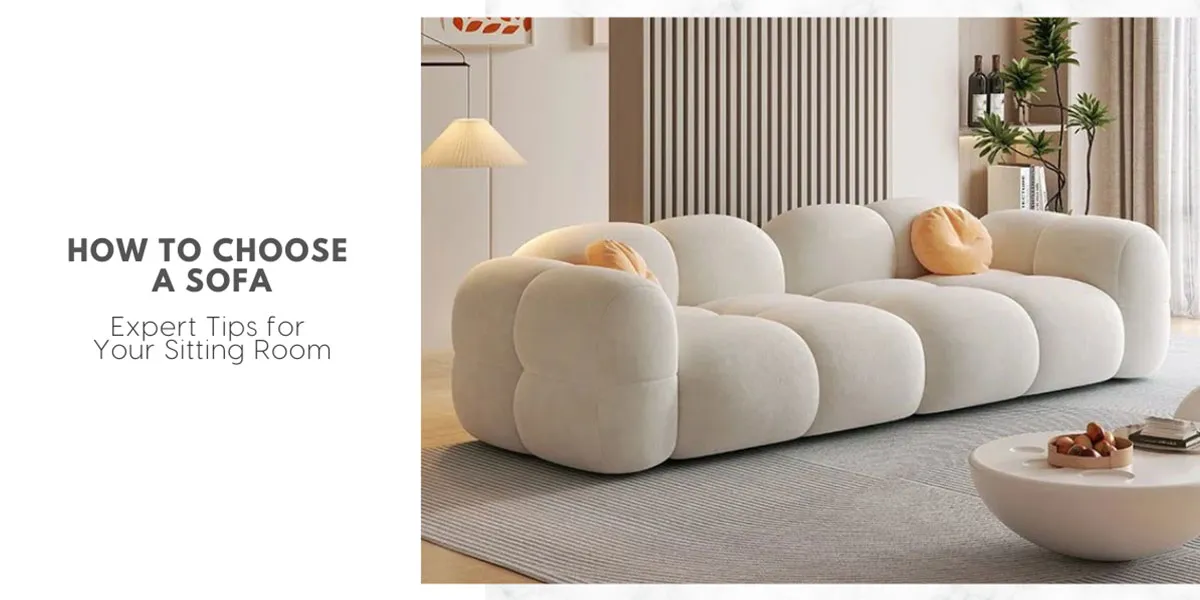How to Choose a Sofa: Expert Tips for Your Sitting Room

The wrong sofa can throw off your entire living room. It might look great online, but once it arrives, it could feel too bulky, uncomfortable, or off in colour. That’s why knowing how to choose a sofa isn’t just about style, it’s about getting the right fit for your space and life.
Whether you’re furnishing a new sitting room or replacing an old couch, this guide will help you make a confident choice. We’ll cover everything: size, fabric, comfort, style, and more.
Start With Function First
Before anything else, think about how you’ll use your sofa every day. This one choice affects every decision that follows. If you have a large family or host friends often, a sectional might suit you best. For smaller spaces or a more minimal setup, a loveseat or a two-seater could be ideal.
Some people want their sofa to double as a guest bed. Others just need a comfy place to unwind at the end of a long day. When you know your primary purpose, you’ll automatically narrow your options and avoid costly mistakes.
Measure Your Space
One of the biggest mistakes people make is buying a sofa that doesn’t fit not just in the room, but also through the door.
Here’s how to pick the right size sofa:
- Calculate the length, width, and height of your living room.
- Leave 30″–36″ of space for walkways around the sofa.
- Measure doorways, stairwells, and elevators before purchasing.
- Use masking tape to mark the sofa footprint on the floor.
A great sofa feels balanced in the space. It should never overwhelm or disappear in the room.
Choose the Right Size and Shape
The shape and scale of your sofa play a significant role in how it fits your room layout. A well-chosen shape can bring balance, create zones, or make a small space feel bigger. When thinking about how to choose a sofa, don’t overlook how its form affects the way your living room functions.
Popular sofa shapes include:
- Love Seat: Best for small spaces or as a companion piece in a larger setup.
- Sectional Sofa: Offers lots of seating and works well in open-concept rooms or large households.
- Corner Sofa: Fits comfortably into the corner of a room and makes smart use of space, ideal for square or boxy layouts.
- L-Shape Sofa: Great for maximising seating along two walls or dividing open spaces into zones like dining and lounging.
- Apartment Sofa: Compact and designed for tight spaces such as condos or studios.
- Chaise Sofa: Features an extended seat on one end, perfect for stretching out and relaxing.
- Sleep Sofa: Adds extra functionality by converting into a bed—handy for guests.
- Modular Sofa: Comes in movable sections so you can rearrange the layout based on your space or needs.
Choosing the right shape means thinking about how the sofa will interact with the room. L-shaped and corner sofas can help define a seating area, especially in open-plan homes. On the other hand, smaller spaces benefit from simpler, more compact designs. The goal is to match the sofa to the room’s flow and your lifestyle.
How to Choose a Sofa Style
Your sofa helps define your room’s personality. Choose a style that fits both your decor and your comfort preferences.
Popular sofa styles to consider:
- Mid-century Modern: Sleek, clean lines with minimal fuss.
- Chesterfield: Deep tufting, rolled arms, classic and formal.
- English Roll Arm: Casual, soft arms, deep seating.
- Tuxedo or Track Arm: Straight arms and back, perfect for a modern look.
- Bridgewater: Relaxed, rounded arms with a comfortable seat depth.
Leg Options
Sofa legs may seem like a small detail, however, they can change the look and stability of the entire piece.
Types of sofa legs include:
- Block Legs: Modern and sturdy.
- Tapered Legs: Offer a sleek, contemporary vibe.
- Bun Feet: Traditional and rounded.
- Metal Legs: Industrial and minimal.
- Turned Legs with Casters: Classic with added mobility.
The right leg style can help your sofa blend in or stand out, depending on your design goals.
Select Your Fabric and Materials
The material you choose affects how the sofa feels, wears, and looks over time. So, consider your lifestyle before picking.
Leather vs fabric sofa:
- Leather: Long-lasting, easy to clean, and ages well, making it great for pets and kids.
- Fabric: Warmer, softer, more colour and texture choices.
- Performance Fabrics: Stain-resistant and ideal for high-traffic homes.
- Velvet: Elegant and plush, but needs more care.
- Microfiber: Soft, affordable, and great for daily use.
If you want both comfort and durability, microfiber or leather could be your best bet.
Pick the colour and Pattern
Your sofa’s colour can either blend into the background or steal the spotlight. The best sofa colours for living room are often neutral tones like grey, beige, or taupe. These shades adapt easily to changing decor trends and work with almost any wall colour or flooring.
Still, there’s nothing wrong with choosing a bold colour if it fits your taste. Navy, emerald green, or rust tones can create a striking focal point. Just make sure the shade complements the rest of your room. Sofas in darker colours or with patterned fabrics also tend to hide wear and stains better, which is specifically useful in homes with children or pets.
Don’t Buy Without Testing
Even the most beautiful sofa can disappoint if it’s not comfortable. Whenever possible, try to test it in person.
When testing a sofa:
- Sit for at least 5–10 minutes.
- Check the depth—can you sit with your feet on the floor comfortably?
- Try the back support. Is it too firm or too soft?
- Lie down if lounging is your goal.
Conclusion
Choosing the right sofa means balancing comfort, style, size, and durability. Measure your space, know your needs, and select a sofa that fits both your lifestyle and your room’s personality. The right sofa will transform your sitting room into a space you’ll love every day.

